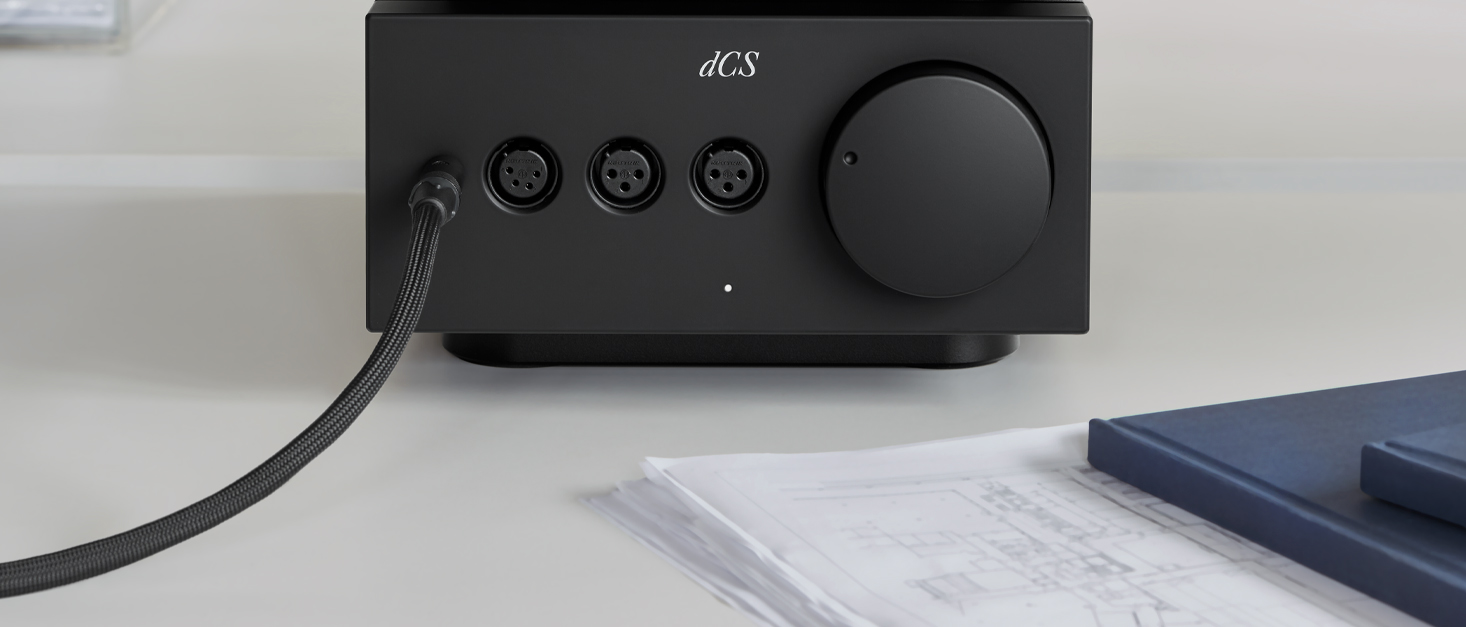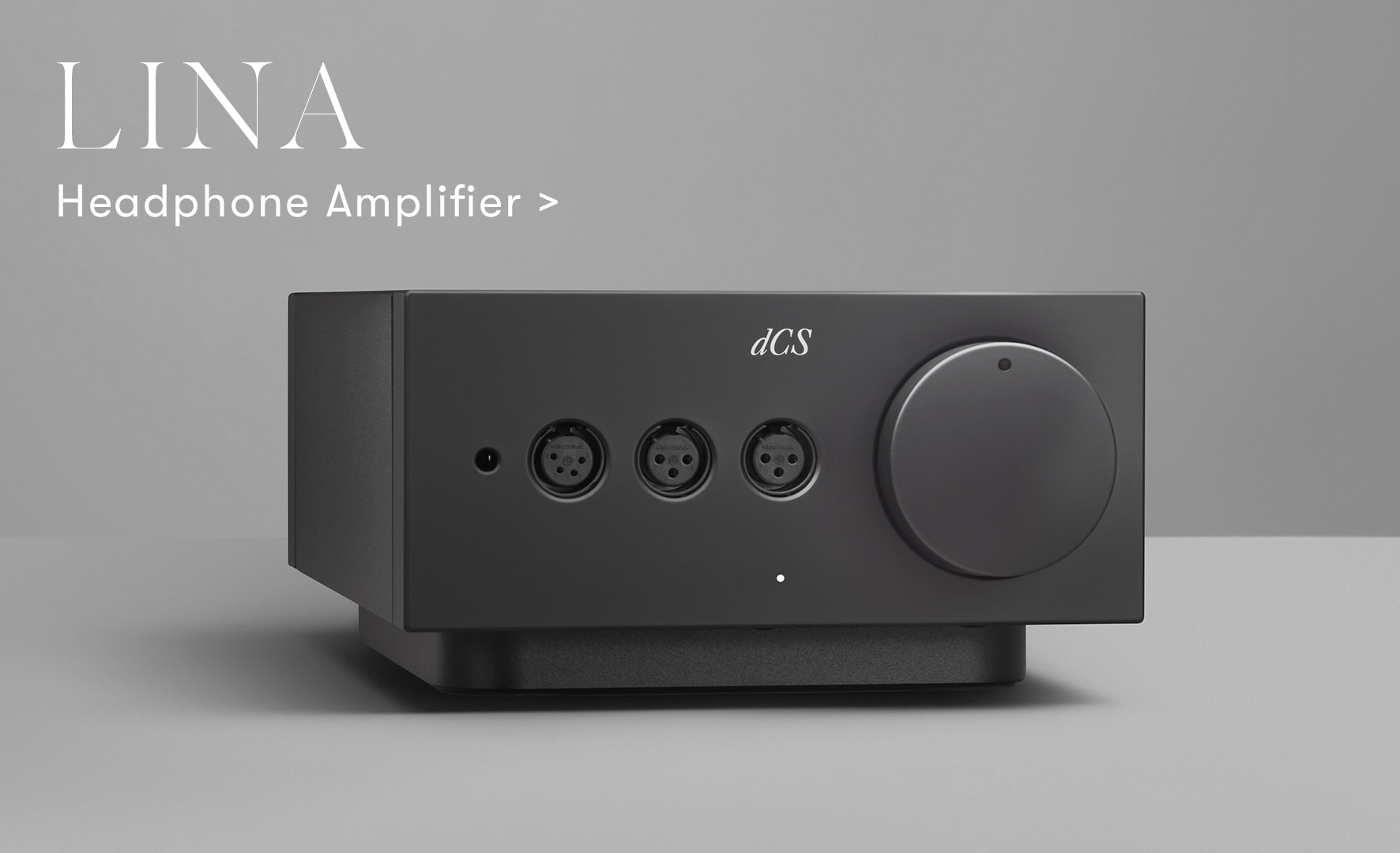Linearity is one of the most important factors we look at when designing and assessing the performance of dCS audio systems. Whilst we have a unique set of design goals for each new product we create, achieving excellent linearity is always a core focus for our engineers.
What is linearity and why is it important in audio?
Linearity is the measure of how directly a device can translate a change at its input to a change on its outputs. An amplifier, for example, must ensure that changes in the incoming analogue signal it receives from a DAC are translated into changes in the amplified signal it delivers at its output. If a device is not linear, then the signal is distorted. At dCS, we consider any distortion of the original signal unacceptable.
Class, linearity and distortion: key design considerations
When designing the Lina Headphone Amplifier, we set out to deliver both excellent drive characteristics and excellent linearity. We developed a Super Class A / Class AA topology, which combines the distortion free characteristics of a Class A design with the efficiency required to drive even inefficient planar magnetic headphones. (See our previous post on drive for more information on amplifier classes.)
Utilising this design offered some major performance benefits, but it also presented some additional challenges - in particular, working out how to avoid crossover distortion when not using a full Class A topology.
Avoiding crossover distortion
With Class AB and Class B amplifiers, when the amplifier transitions from the negative to positive wave cycles (or positive to negative), there is an amount of voltage needed to saturate the collector of the transistor being turned on before the output of the amplifier changes (typically 0.65V for bipolar designs, or much more for MOSFET designs).
This means that there can be a jump in amplitude – an error – when the input waveform crosses over an amplitude of 0, as the amplitude is artificially held at an amplitude of 0 while the transistor is powered up. This distortion is known as crossover distortion, and is a major drawback of a Class B amplifier for audio purposes as it degrades linearity. This is where the preference for Class A tends to come from, as the output transistors in a Class A design are always powered so crossover distortion is not an issue.
The Lina Headphone Amplifier shares this trait: its output transistors are never powered off, but they are also not permanently fully powered, as they would be in a Class A design. To reduce crossover distortion, an error correction mechanism is in place. This means that for each individual output transistor, the difference between the input to the transistor and the output (the error) is fed back into that transistor. This approach provides all of the performance benefits of a Class A system, while also keeping heat and power usage under control.
The signal path within the Lina Headphone Amplifier is kept as clean as possible, as more components in the signal chain can add noise and distortion. The use of relays within the unit means the audio signal does not have to be run back and forth to reach gain switches, input selection etc. There are also no DC blocking capacitors anywhere in the signal chain with the Lina Headphone Amplifier. This is important as capacitors – particularly large electrolytic capacitors – are inherently non-linear, and will impact the sonic performance of the product. The use of the DC servo circuit negates the need for DC blocking capacitors on the input or output of the amp. The unit does so without the audio signal ever running through the servo circuit, ensuring a clean signal path.
Buffered and unbuffered inputs
Early on in our design process, we decided the Lina Headphone Amplifier should have both buffered and unbuffered inputs. It is commonplace for headphone amplifier designers to have a higher input impedance on their product so that the unit can be driven by any source, irrespective of the source device’s output impedance. With the Lina Headphone Amplifier, the buffered input provides this function – the buffered balanced input impedance is 96kΩ. If such an input with a high input impedance is the only input available on an amplifier however, the unit will not be able to get the best performance from a source device with a suitably low output impedance. With this in mind, we decided to add an additional unbuffered input to enhance performance when using a low output impedance source.
The unbuffered input on the Lina Headphone Amplifier utilises the same approach that we would take if the DAC and amplifier were combined in one chassis, and assumes a low output impedance from the source device. This allows a technique called shunt feedback to be employed throughout the signal path, which involves grounding the positive input of each amplifier stage, and feeding the signal into the negative input only. When both inputs are driven, the amplifier stage must accurately subtract the two signals.
Any imperfection in the subtraction creates a form of distortion known as common mode distortion. Shunt feedback eliminates the common mode, reducing distortion and improving overall performance. Utilising this input requires a sufficiently low output impedance from the source device, so if the amplifier is used with a source device with, for example, a 1kΩ output impedance, it will be preferable to use the buffered input instead (for reference, the output impedance of the Lina DAC is 3Ω). Some cables connecting the source device to the amplifier, if they are also of a high impedance, might warrant the use of the buffered input. The unbuffered input stage of the amplifier borrows technology directly from the dCS 904, an analogue-to-digital converter used in professional recording studios.
The buffered input and the volume control also leverage an approach used elsewhere in the dCS range, where compound op-amps are used to create an exceptionally linear line output stage for our DACs. This is a proprietary approach that gives fantastic performance, and one we were keen to utilise in the Lina Headphone Amplifier.
Low impedance, low feedback
Unlike many solid state designs, the Lina Headphone Amplifier does not use output devices in parallel. Rather, it features unusually large / high current devices for a headphone amplifier. This, combined with local feedback, achieves very low open-loop output impedance, which is a crucial aspect of the design. Each power amplifier stage uses one op-amp and 16 discrete transistors. The op-amp is carefully chosen, but the main performance attributes of the amplifier come from the discrete circuit. We use the best available op-amps, but we also ensure the signal is never sent through an unenhanced single op-amp stage - a key design aspect of the unit.
Feedback is another key consideration in amplifier design (the process of feeding the output of an amplifier to the input). Many high-feedback designs use feedback to hide problems in the output stages. Low feedback is desirable because it minimises Transient Intermodulation Distortion (TIM), an audible type of distortion that degrades the sound quality an amplifier produces. The Lina Headphone Amplifier avoids TIM through the following characteristics:
The amplifier then employs moderately high global feedback as this achieves the best resultant sound quality when the amplifier is already an excellent open-loop design. This is a part of what provides the Lina Headphone Amplifier with the ‘relaxed’ sound that listeners will be familiar with.
Aiming for neutrality: output impedance and headphone characteristics
Some headphone amplifier manufacturers opt to have a higher output impedance from the amplifier, which consequently alters the characteristics of the headphones attached to it. When designing the Lina Headphone Amplifier, we avoided this approach, and sought instead to achieve neutrality. This was of great importance to us, as tuning for a particular type of headphones or set of characteristics can often result in improved sound quality with some headphones, and reduced sound quality with others, something we were keen to avoid when creating an amp that is designed to drive a vast range of headphones to the best of their abilities.
Warm, cold or transparent?
Voice is an important consideration in amplifier design. Audio amplifiers are often described as having a ‘warm’ or ‘cold’ sound, and if a product is deemed too ‘cold’ or ‘analytical’ during testing, then its designer might be tempted to add warmth. Tuning for a particular sound can have some major drawbacks, however, resulting in a product that delivers excellent performance in some audio setups, and a less than optimal experience in others. An alternative solution would be adding transparency to counter any harshness, while also maintaining neutrality.
When creating the Lina Headphone Amplifier, we set out to develop a transparent design with a neutral voice. This enabled us to ensure our amp could deliver an outstanding performance in a wide range of audio setups.
The output impedance of the Lina Headphone Amplifier is very low, but we were careful not to push this aspect of the design to extremes. If we had opted for an output impedance down in the micro- or milli-ohms, we would not have been able to use passive Electromagnetic Compatibility (EMC) components in the product to ensure it is optimised for radio frequencies, both for interference and spurious outputs. The output impedance of the amplifier is sufficiently low that it is not a factor in the voicing of the sound, but not so low that it would begin to create issues with interference due to lack of EMC components.
This approach would not be suitable in a loudspeaker amplifier, where a very high damping factor is paramount. Very low output impedance is also critical, as a loudspeaker system will almost always have a crossover, which can cause real problems if the amplifier’s output impedance is not sufficiently low. As this is not the case with headphones, the output impedance of the amplifier does not need to be quite so low to achieve optimum performance.
There are several factors to consider when it comes to linearity - all of which were given careful thought when developing the Lina Headphone Amplifier. In the next instalment of this series, we’ll discuss flexibility, and explain how we approached creating an amplifier that can be used with any digital source and any pair of headphones.

Testing the Lina Headphone Amplifier's Linearity: reviews and feedback
'dCS manages to balance voltage and current requirements such that the Lina headphone amp can handle both high and low impedance headphones.
It also has a physical high/low gain switch at the bottom of the front of the unit. Although I generally do not use IEMs in a desktop environment, I did try out the qdc Anole V14 with the Lina amp in the low gain setting, and the V14 sounded better than I had ever heard it before.'
Jude Mansilla, Headfi.org
‘Super tight and clean delivery, but with great depth, layering and precision.
I also adore the vibrant, spacious mids and natural vocal presentation’
'If you’re looking for the very best in digital reproduction, Lina delivers. Completely blew me away with its transparency and uncolored sound.'
Lieven Vranken, Headfonia
‘The Lina amp just gets out of the way and opens up to the exceptional uncolored sound.’
Frank Iacone, Headphone Guru
'Lina colours nothing...it lets the music flow through as it was recorded.
It represents perfect neutrality.'
Jeremy Lim, Zeppelin & Co
Read all reviews for the dCS Lina Headphone Amplifier
Where can I find out more about the Lina Headphone Amplifier?
Full specifications, links to global dealer outlets, can be found at the dCS Lina Headphone Amplifier Product Page.
Read the articles below to learn more about the Lina Headphone Amplifier's design and performance.
The Lina Headphone Amplifier: Drive
The Lina Headphone Amplifier: Flexibility
Make sure you Subscribe to our Mailing List to receive the latest news and content from dCS.
Images courtesy of Zeppelin & Co
















